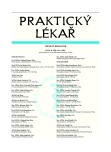Tick-borne meningoencephalitis
Authors:
J. Havlík
Authors‘ workplace:
1. Infekční klinika 2. LF UK, FN Na Bulovce, Praha
; Přednostka: doc. MUDr. Vilma Marešová, CSc.
; Univerzita Karlova v Praze
Published in:
Prakt. Lék. 2010; 90(2): 69-72
Category:
Reviews
Overview
The tick-borne meningoencephalitis virus has probably circulated among animals in localised natural habitats for a very long time. Human infections appeared for the first time in central Europe in the 1940’s, however they rapidly spread to most of the countries of the continent. There are currently about 10,000 reported cases of tick borne meningoencephalitis in Europe, of which 500–1 000 are in the Czech Republic. Small rodents act as a reservoir of infection, the Ixodes ricinus tick in any developmental phase then becomes infected from sucking the blood of the rodent. These ticks then spread infection in both healthy animals and humans. Safe protection against this potentially life threatening disease is provided by an inactivated vaccine.
Key words:
ticks, meningoencephalitis, natural habitats, inactivated vaccines.
Sources
1. Heinz, F.X. Etiology. In: Management of tick-borne encefalitis. Baxter 2006, p. 7-16.
2. Danielová, V. Epidemiologie klíšťové encefalitidy. Zdravotnické noviny-Diagnoza 2000, 5, s. 8.
3. Schneider, H. Über epidemische akute „Meningitis serosa“. Wien Klin Wochenschrift 1931, 44, s. 350-352.
4. Havlík, J., Marsa, J., Potužník, V. Klíšťová encefalitida na Českobudějovicku. Prakt. Lék. 1956, 36(12), s. 271-273.
5. Zeman, P., Benes, C. A tick-borne encefalitis ceiling in Central Europe has moved upwards during the last 30 years: possible impact of global warming? Int. J. Med. Microbiol. 2004, 293, Suppl 37, p. 48-54.
6. Havlík, J. Klíšťová encefalitida a jak nákaze předejít. Postgrad. Med. 2006, 8(3), s. 926-929.
7. Havlík, J. Onemocnění přenášená klišťaty – prevence a léčba u dětí. Pediatrie po promoci 2005, II/5, s. 25-30.
8. Heinz, F.X. Molecular aspects of TBE virus research. Vaccine 2003, 21(1), p. 3-10.
9. Holzmann, H., Vorobyova, M.S., Landyshenskaya, I.P. et al. Molecular epidemiology of tick-borne encefalitis virus: cross-protection between European and Far Eastern serotypes. Vaccine 1992, 10, p. 345-349.
10. Galia, F., Rampas, J., Hollender, L. Laboratorní infekce encefalitickým virem. Čas. Lék. Čes. 1949, 88, s. 224-229.
11. Chmelík, V. Klíšťová meningoencefalitida. Pediatrie pro praxi 2009, 10(5), s. 306-310.
12. Ternovoi, V.A., Korzhukov, G.P., Sokolov, Y.V. et al. Tick-borne encephalitis with hemorrhagic syndrome, Novosibirsk region, Russia, 1999. Emerg. Infect. Dis. 2003, 9(6), p. 743-746.
13. Zent, O., Broker, M. Tick-borne encephalitis vaccines: past and present. Expert. Rev. Vaccines. 2005, 4, p. 747-755.
14. Kunz, C.H., Hofmann, H., Stary, A. Field studies with a new tick-borne encephaitis (TBE) vaccine. Zbl. Bakt. Orig. 1976, 243, p. 141-144.
15. Bok, H., Klockmann, U., Juengst, C. et al. A new vaccine against tick-borne encefalitis: initial trial in man including a dose-response study. Vaccine 1990, 8, p. 22-24.
16. Girsgdies, O.E., Rosenkranz, G. Tick-borne encephalitis development of a pediatric vaccine. A controlled, randomised, double-blind and multicentre study. Vaccine 1996, 14, p. 1421-1428.
17. Kunz, C.H. TBE vaccination and the Austrian experience. Vaccine 2003, 21(1), p. 50-55.
18. Havlík, J. Vliv očkování na výskyt klíšťové meningoencefalitidy v České republice. Postgrad. Med. 2009, 11(6), p. 615-618.
Labels
General practitioner for children and adolescents General practitioner for adultsArticle was published in
General Practitioner

2010 Issue 2
Most read in this issue
- Tracheal stenosis, diagnosis and treatment options
- Radicular syndrome in the general practitioner’s surgery
- Differential diagnosis of oedema
- Substance abuse preventinon and approaches to managing of cure dependence
